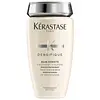What's inside
What's inside
 Key Ingredients
Key Ingredients

 Benefits
Benefits

 Concerns
Concerns

 Ingredients Side-by-side
Ingredients Side-by-side

Water
Skin ConditioningSodium Laureth Sulfate
CleansingDisodium Cocoamphodiacetate
CleansingGlycol Distearate
EmollientHexylene Glycol
EmulsifyingSodium Lauryl Sulfate
CleansingSodium Chloride
MaskingParfum
MaskingSodium Benzoate
MaskingSodium Hydroxide
BufferingCitric Acid
BufferingCoco-Betaine
CleansingHydroxypropyl Guar Hydroxypropyltrimonium Chloride
Alcohol Denat.
AntimicrobialPolyquaternium-30
Salicylic Acid
MaskingCarbomer
Emulsion StabilisingHexyl Cinnamal
PerfumingArginine
MaskingGlutamic Acid
HumectantLinalool
PerfumingCitronellol
PerfumingSerine
MaskingAlpha-Isomethyl Ionone
PerfumingHydroxypropyltrimonium Hydrolyzed Wheat Protein
Skin ConditioningSodium Hyaluronate
Humectant2-Oleamido-1,3-Octadecanediol
Skin ConditioningSafflower Glucoside
Geraniol
PerfumingPhenoxyethanol
PreservativeTocopherol
AntioxidantSodium Citrate
BufferingWater, Sodium Laureth Sulfate, Disodium Cocoamphodiacetate, Glycol Distearate, Hexylene Glycol, Sodium Lauryl Sulfate, Sodium Chloride, Parfum, Sodium Benzoate, Sodium Hydroxide, Citric Acid, Coco-Betaine, Hydroxypropyl Guar Hydroxypropyltrimonium Chloride, Alcohol Denat., Polyquaternium-30, Salicylic Acid, Carbomer, Hexyl Cinnamal, Arginine, Glutamic Acid, Linalool, Citronellol, Serine, Alpha-Isomethyl Ionone, Hydroxypropyltrimonium Hydrolyzed Wheat Protein, Sodium Hyaluronate, 2-Oleamido-1,3-Octadecanediol, Safflower Glucoside, Geraniol, Phenoxyethanol, Tocopherol, Sodium Citrate
Water
Skin ConditioningCamellia Sinensis Leaf Extract
AntimicrobialCymbopogon Schoenanthus Extract
Skin ConditioningAloe Barbadensis Leaf Extract
EmollientSodium C16 Olefin Sulfonate
EmulsifyingCoco-Betaine
CleansingSodium Chloride
MaskingSaccharum Officinarum Extract
MoisturisingGlycerin
HumectantCaprylic Acid
CleansingGlycine
BufferingOenocarpus Bataua Seed Oil
EmollientHydrolyzed Quinoa
Skin ConditioningRosmarinus Officinalis Leaf Extract
AntimicrobialPotassium Sorbate
PreservativeLavandula Angustifolia Oil
MaskingEucalyptus Globulus Leaf Oil
PerfumingCitric Acid
BufferingPanthenol
Skin ConditioningCI 75810
Cosmetic ColorantWater, Camellia Sinensis Leaf Extract, Cymbopogon Schoenanthus Extract, Aloe Barbadensis Leaf Extract, Sodium C16 Olefin Sulfonate, Coco-Betaine, Sodium Chloride, Saccharum Officinarum Extract, Glycerin, Caprylic Acid, Glycine, Oenocarpus Bataua Seed Oil, Hydrolyzed Quinoa, Rosmarinus Officinalis Leaf Extract, Potassium Sorbate, Lavandula Angustifolia Oil, Eucalyptus Globulus Leaf Oil, Citric Acid, Panthenol, CI 75810
 Reviews
Reviews

Ingredients Explained
These ingredients are found in both products.
Ingredients higher up in an ingredient list are typically present in a larger amount.
Citric Acid is an alpha hydroxy acid (AHA) naturally found in citrus fruits like oranges, lemons, and limes.
Like other AHAs, citric acid can exfoliate skin by breaking down the bonds that hold dead skin cells together. This helps reveal smoother and brighter skin underneath.
However, this exfoliating effect only happens at high concentrations (20%) which can be hard to find in cosmetic products.
Due to this, citric acid is usually included in small amounts as a pH adjuster. This helps keep products slightly more acidic and compatible with skin's natural pH.
In skincare formulas, citric acid can:
While it can provide some skin benefits, research shows lactic acid and glycolic acid are generally more effective and less irritating exfoliants.
Most citric acid used in skincare today is made by fermenting sugars (usually from molasses). This synthetic version is identical to the natural citrus form but easier to stabilize and use in formulations.
Read more about some other popular AHA's here:
Learn more about Citric AcidCoco-Betaine is the natural version of Cocamidopropyl Betaine. It is often derived from coconuts.
Coco-Betaine is a surfactant, meaning it helps remove dirt and oil from the skin.
Chances are, you eat sodium chloride every day. Sodium Chloride is also known as table salt.
This ingredient has many purposes in skincare: thickener, emulsifier, and exfoliator.
You'll most likely find this ingredient in cleansers where it is used to create a gel-like texture. As an emulsifier, it also prevents ingredients from separating.
There is much debate on whether this ingredient is comedogenic. The short answer - comedogenic ratings don't tell the whole story. Learn more about comegodenic ratings here.
The concensus about this ingredient causing acne seems to be divided. Research is needed to understand if this ingredient does cause acne.
Scrubs may use salt as the primary exfoliating ingredient.
Learn more about Sodium ChlorideWater. It's the most common cosmetic ingredient of all. You'll usually see it at the top of ingredient lists, meaning that it makes up the largest part of the product.
So why is it so popular? Water most often acts as a solvent - this means that it helps dissolve other ingredients into the formulation.
You'll also recognize water as that liquid we all need to stay alive. If you see this, drink a glass of water. Stay hydrated!
Learn more about Water